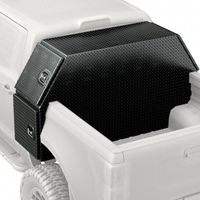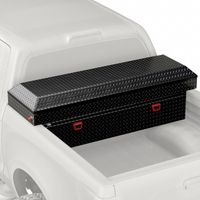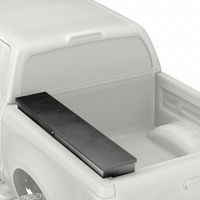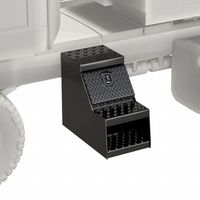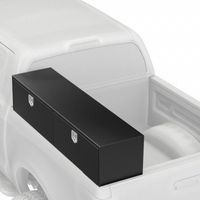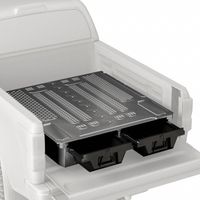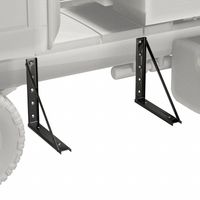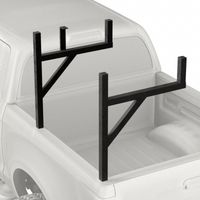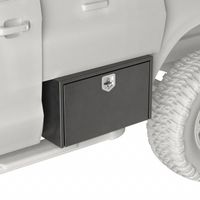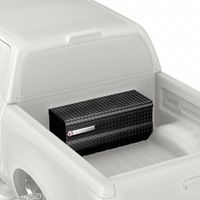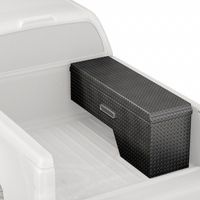Call +(254) 703 030 000 / 751 483 999 / 721 704 777
- Home
- Fleet Vehicle Maintenance
- Vehicle Accessories
- Vehicle Storage
- Truck Storage
Truck Storage
Truck storage consists of boxes, drawers, and racks that hold, secure, and organize tools, equipment, and supplies. Crossover truck boxes sit flush behind the cab and span the width of the truck bed, mounting onto the bed's outer rails to free floor space. Side-mount truck boxes install alongside th .....Read More
Frequently Asked Questions
What are the different types of truck storage boxes?
There are several types of truck storage boxes, each designed to meet specific needs and preferences:
1. **Crossover Toolboxes**: These are the most common type, mounted behind the cab and spanning the width of the truck bed. They are accessible from the sides and provide ample storage without taking up bed space.
2. **Side-Mount Toolboxes**: Installed along the sides of the truck bed, these boxes offer easy access to tools and equipment without climbing into the bed. They are ideal for storing frequently used items.
3. **Chest Toolboxes**: Positioned directly on the truck bed floor, these boxes do not extend above the bed rails, allowing for a low-profile look. They provide significant storage space and are often used for larger items.
4. **Underbody Toolboxes**: Mounted beneath the truck bed, these boxes are typically used on service or utility trucks. They maximize storage without occupying bed space, ideal for heavy-duty applications.
5. **Wheel Well Toolboxes**: Designed to fit over the wheel wells, these boxes utilize otherwise wasted space. They are perfect for storing smaller tools and equipment while leaving the central bed area open.
6. **Hitch-Mount Toolboxes**: Attached to the truck's hitch receiver, these boxes are portable and can be easily removed. They are suitable for additional storage when the bed is full.
7. **Gull-Wing Toolboxes**: Featuring two lids that open from the center, these boxes allow access from either side of the truck. They are similar to crossover toolboxes but offer more versatile access.
8. **Fifth Wheel Toolboxes**: Specifically designed for trucks with fifth-wheel hitches, these boxes provide storage without interfering with the hitch operation.
9. **Trailer Tongue Toolboxes**: Mounted on the tongue of a trailer, these boxes offer extra storage for tools and equipment needed during towing.
Each type of truck storage box offers unique benefits, catering to different storage needs and vehicle configurations.
How do crossover truck boxes differ from side-mount truck boxes?
Crossover truck boxes and side-mount truck boxes differ primarily in their placement, design, and functionality.
Crossover truck boxes, also known as saddle boxes, are mounted directly behind the cab of the truck and span the width of the truck bed, resting on the bed rails. They are designed to provide ample storage space without occupying the entire bed, allowing for the transportation of larger items underneath. Crossover boxes are typically accessed from the top via a hinged lid, which often features a lock for security. They are ideal for storing tools and equipment that need to be easily accessible and are commonly used by contractors and tradespeople.
Side-mount truck boxes, on the other hand, are installed along the sides of the truck bed, either on one or both sides. These boxes are mounted on the bed rails and extend down into the bed, but they do not span the entire width. Side-mount boxes are accessed from the side, usually through a door that opens outward. This design allows for easy access to tools and equipment without having to climb into the truck bed. Side-mount boxes are particularly useful for organizing smaller items and keeping them within reach.
In summary, crossover truck boxes offer a larger, centralized storage solution that maximizes bed space, while side-mount truck boxes provide convenient, organized access to tools along the sides of the truck bed. The choice between the two depends on the user's specific storage needs and how they intend to use their truck bed space.
What is the purpose of a wheel well truck box?
A wheel well truck box, also known as a wheel well tool box or fender well box, is designed to maximize storage space in a pickup truck by fitting over the wheel well area in the truck bed. Its primary purpose is to provide secure, organized storage for tools, equipment, and other items while utilizing space that is often underutilized due to the protrusion of the wheel wells.
These boxes are particularly useful for tradespeople, contractors, and outdoor enthusiasts who need to carry a variety of tools and equipment but want to keep the main bed area free for larger items. By fitting snugly over the wheel wells, these boxes allow for efficient use of space without significantly reducing the available floor area of the truck bed.
Wheel well truck boxes are typically constructed from durable materials such as aluminum, steel, or heavy-duty plastic to withstand harsh weather conditions and the rigors of daily use. They often feature lockable lids to ensure the security of the contents, protecting valuable tools and equipment from theft.
Additionally, these boxes can be customized with dividers, trays, and compartments to enhance organization, making it easier to access specific items quickly. This organization is crucial for professionals who need to maintain efficiency and productivity on the job site.
In summary, the purpose of a wheel well truck box is to provide a practical, secure, and organized storage solution that maximizes the use of space in a pickup truck bed, particularly around the wheel wells, while keeping the main bed area available for larger cargo.
How do utility chest truck boxes affect rearview visibility?
Utility chest truck boxes are designed to sit directly on the bed floor of a truck, typically positioned right behind the cab. Their impact on rearview visibility can vary based on several factors:
1. **Height and Size**: If the utility chest is tall, it can obstruct the lower portion of the rear window, limiting the driver's ability to see directly behind the vehicle. This is particularly true for larger boxes that extend above the bed rails.
2. **Positioning**: Since these boxes are placed on the truck bed floor, they generally do not obstruct the upper portion of the rear window. However, if the box is positioned too close to the rear window, it can still impede visibility.
3. **Design Features**: Some utility chests come with a low-profile design, minimizing their impact on rearview visibility. These are specifically designed to sit below the line of sight through the rear window.
4. **Additional Equipment**: If the utility chest is used to store or mount additional equipment, such as tools or machinery, this can further obstruct the view.
5. **Rearview Mirrors and Cameras**: Modern trucks often come equipped with rearview cameras and extended side mirrors, which can mitigate the visibility issues caused by utility chests. These technologies provide alternative ways to monitor the area behind the truck.
6. **Driving Conditions**: In certain driving conditions, such as when reversing or parking, the obstruction caused by a utility chest can be more problematic, necessitating extra caution.
In summary, while utility chest truck boxes can affect rearview visibility, the extent of this impact depends on their size, design, and positioning, as well as the presence of supplementary visibility aids like cameras and mirrors.
What are the benefits of using a truck bed drawer system?
A truck bed drawer system offers several benefits, enhancing both the functionality and organization of a truck. Firstly, it maximizes storage efficiency by utilizing the full depth and width of the truck bed, allowing for organized storage of tools, equipment, and personal items. This organization reduces clutter and makes it easier to locate items quickly, saving time and effort.
Secondly, these systems provide enhanced security. Many drawer systems come with lockable features, protecting valuable items from theft and unauthorized access. This is particularly beneficial for professionals who carry expensive tools or equipment.
Thirdly, a truck bed drawer system improves accessibility. Items stored in the drawers can be easily accessed without the need to climb into the truck bed, reducing physical strain and making it convenient to retrieve items, especially for those with mobility issues.
Additionally, these systems protect stored items from the elements. Many are designed to be weather-resistant, safeguarding contents from rain, snow, and dust, which is crucial for maintaining the condition of tools and equipment.
Moreover, a drawer system can enhance the resale value of a truck. It is an attractive feature for potential buyers who value organization and security, making the vehicle more appealing in the market.
Lastly, a truck bed drawer system can be customized to fit specific needs. Various configurations and sizes are available, allowing users to tailor the system to their specific requirements, whether for work, recreation, or personal use.
In summary, a truck bed drawer system offers improved organization, security, accessibility, protection from the elements, potential resale value enhancement, and customization, making it a valuable addition for truck owners.
How do underbody truck boxes differ from topside truck boxes?
Underbody truck boxes and topside truck boxes serve different purposes and are installed in distinct locations on a truck, leading to differences in design, functionality, and accessibility.
Underbody truck boxes are mounted beneath the truck bed, typically between the wheels and the cab. They are designed to utilize the otherwise unused space under the truck, providing storage without taking up bed space. These boxes are ideal for storing tools and equipment that need to be accessed from the side of the vehicle. They are often constructed from durable materials like steel or aluminum to withstand road debris and harsh conditions. Underbody boxes are usually weather-resistant and lockable, offering secure storage. Their placement makes them less accessible than topside boxes, requiring the user to bend down or kneel to reach the contents.
Topside truck boxes, on the other hand, are mounted on top of the truck bed rails. They are designed to provide easy access to tools and equipment from the side of the truck without having to climb into the bed. These boxes are often used by professionals who need quick access to their tools, such as contractors or utility workers. Topside boxes are typically made from lightweight materials like aluminum to avoid adding excessive weight to the truck. They often feature multiple compartments and drawers for organized storage. While they offer convenient access, they can limit the use of the truck bed for larger cargo, as they occupy space above the bed rails.
In summary, underbody truck boxes maximize under-truck space for secure storage, while topside truck boxes offer easy side access at the cost of some bed space.
What is the function of a truck rack?
A truck rack serves multiple functions, primarily aimed at enhancing the utility, safety, and efficiency of a truck. It provides additional storage space by allowing users to carry oversized or elongated items such as ladders, lumber, kayaks, or pipes that would not fit within the truck bed. This is particularly beneficial for tradespeople, outdoor enthusiasts, and anyone needing to transport large items.
Truck racks also help in organizing cargo, preventing damage to both the items being transported and the truck itself. By securing items above the truck bed, they reduce the risk of scratches, dents, or other damage that might occur if items were loosely placed in the bed. This organization also contributes to safer driving conditions by ensuring that cargo is securely fastened and does not shift during transit, which could otherwise lead to accidents.
Additionally, truck racks can improve the aerodynamics of a vehicle when properly loaded, potentially enhancing fuel efficiency. They also free up space in the truck bed for other cargo, maximizing the truck's load capacity.
For businesses, truck racks can be a valuable asset, allowing for the transport of tools and materials necessary for various jobs, thereby increasing productivity and efficiency. They can also be customized with additional features such as toolboxes, lighting, or tie-down points to further enhance their functionality.
In summary, the primary functions of a truck rack include increasing storage capacity, organizing and securing cargo, protecting the truck and its contents, improving safety, and potentially enhancing fuel efficiency. These benefits make truck racks a versatile and practical accessory for both personal and professional use.
